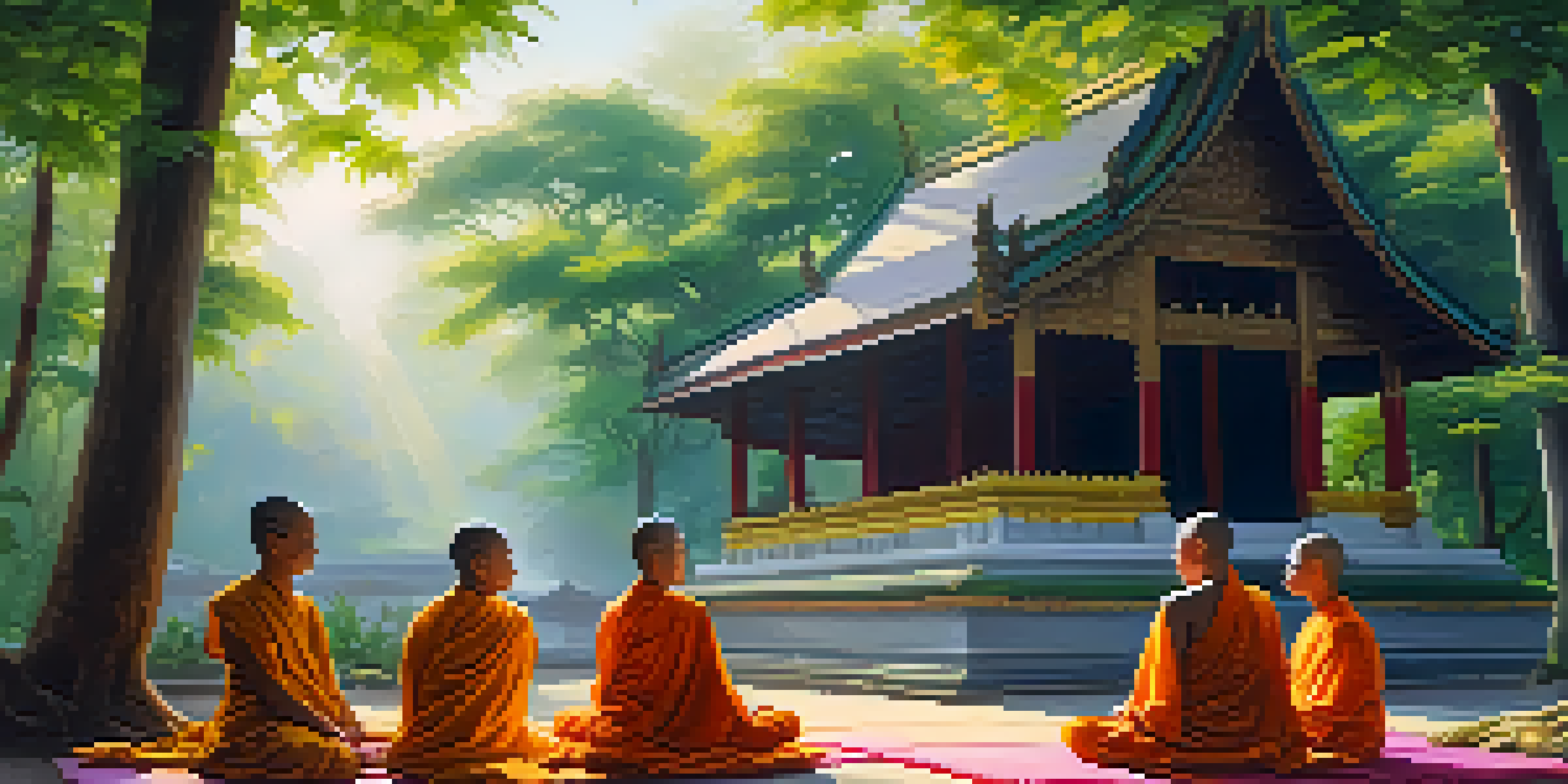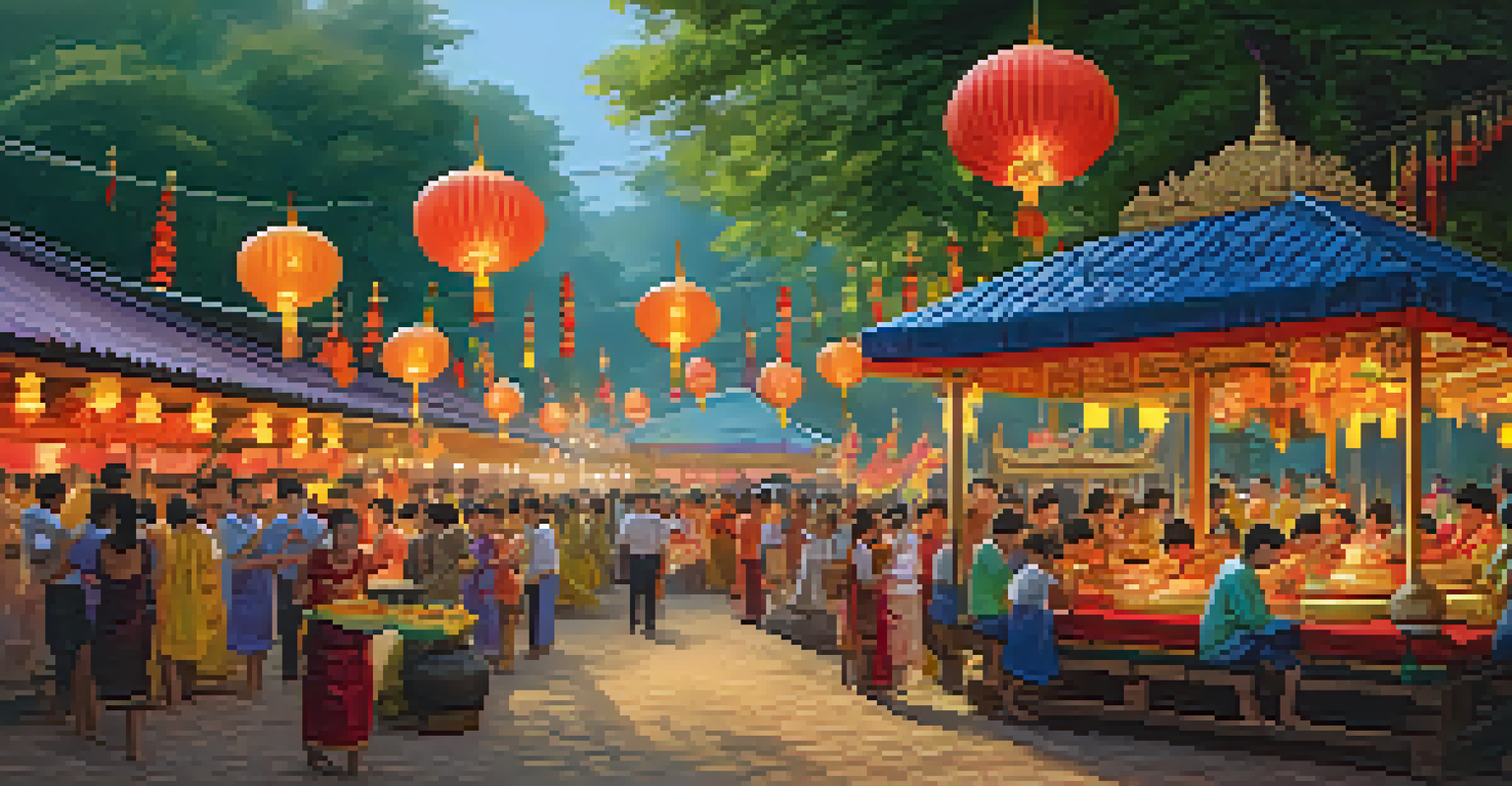The Role of Buddhist Texts in Shaping Thai Literary Traditions

Understanding the Foundations of Thai Literary Traditions
Thai literary traditions are deeply rooted in the country's cultural and religious landscape, primarily shaped by Buddhism. Since the arrival of Buddhism in Thailand, its teachings and texts have profoundly influenced various art forms, including literature. This intertwining of faith and creativity has created a rich tapestry of stories, poems, and philosophical writings that reflect the Thai worldview.
Literature is the most agreeable way of ignoring life.
These traditions were not developed in isolation but rather evolved through the interaction of indigenous beliefs with Buddhist principles. The result is a unique blend that often includes moral lessons, spiritual guidance, and reflections on life and death. As a result, Thai literature often mirrors the teachings found in Buddhist scriptures, inviting readers to contemplate their own lives and the nature of existence.
Moreover, the accessibility of Buddhist texts has allowed them to serve as a source of inspiration for countless writers throughout history. From ancient manuscripts to contemporary works, the influence of these texts is evident in the themes, characters, and narratives that permeate Thai literature.
The Significance of the Pali Canon in Thai Literature
The Pali Canon, considered the authoritative scripture of Theravada Buddhism, plays a pivotal role in shaping Thai literary traditions. Comprising three 'baskets' of teachings, the Canon serves as both a spiritual guide and a literary reference. Many Thai writers have drawn inspiration from its teachings, utilizing its stories and principles to craft their own narratives.

One notable aspect of the Pali Canon is its emphasis on moral conduct and the pursuit of enlightenment. These themes resonate deeply within Thai literature, often manifesting in the characters' journeys toward self-realization and ethical living. For instance, the moral dilemmas faced by protagonists can often be traced back to the teachings found within these texts.
Buddhism Shapes Thai Literature
Thai literary traditions are profoundly influenced by Buddhist teachings, intertwining moral lessons with creative expression.
Additionally, the Pali Canon has influenced the language and style of Thai literature. Its poetic structure and rhythmic qualities have inspired numerous poets and authors to experiment with similar forms, resulting in a distinct literary style that reflects both spiritual depth and artistic creativity.
Influence of Jataka Tales on Thai Storytelling
Jataka Tales, stories about the previous lives of the Buddha, are a vital component of Thai literature and culture. These tales not only carry moral lessons but also entertain and educate readers about the virtues of compassion, wisdom, and selflessness. Their narratives often feature animals and humans alike, making them relatable to audiences of all ages.
The purpose of literature is to turn blood into ink.
In Thai storytelling, the Jataka Tales have become a popular source for folklore and theatrical performances. Many traditional Thai plays and puppet shows incorporate these tales, bringing valuable lessons to life through engaging stories. This method of storytelling fosters a sense of community, as audiences gather to reflect on shared values and moral teachings.
Moreover, the Jataka Tales serve as a bridge connecting Buddhist teachings to everyday life in Thailand. By portraying the Buddha's previous incarnations, these tales emphasize the importance of ethical behavior and the impact of one's actions, reinforcing the Buddhist concept of karma within Thai society.
Buddhist Philosophy in Modern Thai Literature
As Thai literature has evolved, so too has the integration of Buddhist philosophy into contemporary works. Modern Thai writers often explore existential themes, drawing from Buddhist concepts such as impermanence and the nature of suffering. This philosophical depth enriches their storytelling, allowing readers to engage with complex ideas in relatable ways.
For instance, several contemporary novels delve into characters' struggles with identity and purpose, reflecting the Buddhist understanding of self and the quest for enlightenment. These narratives often challenge readers to reflect on their own lives and the transient nature of existence, fostering a deeper connection to the text.
Pali Canon's Literary Significance
The Pali Canon serves as a foundational text, guiding Thai writers in their exploration of themes like moral conduct and enlightenment.
Furthermore, the blending of traditional Buddhist themes with modern storytelling techniques has led to a vibrant literary scene in Thailand. Writers are not only preserving age-old teachings but also reinterpreting them for a new generation, making Buddhist philosophy accessible and relevant in today's fast-paced world.
Role of Monastic Institutions in Literary Development
Monastic institutions have historically played a crucial role in the development of Thai literature, serving as centers of learning and preservation. Monks often acted as scribes and educators, transcribing ancient texts and composing their own works to disseminate Buddhist teachings. This dedication to literature has helped maintain the cultural and spiritual heritage of Thailand through the centuries.
Moreover, monasteries have been instrumental in fostering a love for reading and writing among the Thai populace. Many locals would visit temples to access Buddhist texts and teachings, leading to a broader appreciation for literature as a whole. This connection between religion and education has cultivated a literary culture that values knowledge and wisdom.
In recent years, there has been a renewed interest in the role of monastic institutions in contemporary literary practices. With an increasing number of monks engaging in creative writing and literary criticism, the synergy between Buddhism and literature continues to thrive, influencing the direction of Thai literary traditions.
The Impact of Buddhist Rituals on Literary Expression
Buddhist rituals and ceremonies have a significant impact on literary expression in Thailand, often inspiring poetry, prose, and song. These rituals, which embody the essence of Buddhist teachings, provide a rich backdrop for writers to explore themes of devotion, spirituality, and community. The emotional resonance of these practices translates into powerful literary works.
For example, the act of almsgiving, a fundamental Buddhist practice, has been depicted in numerous literary forms, emphasizing themes of generosity and compassion. Such narratives can evoke a sense of reflection in readers, encouraging them to consider the impact of their actions on others and their own spiritual journey.
Modern Fusion of Tradition and Innovation
Contemporary Thai literature balances traditional Buddhist themes with modern storytelling techniques, ensuring cultural relevance in today's world.
Additionally, the integration of Buddhist rituals in literature fosters a sense of connection between the written word and lived experience. By weaving elements of ritual into their narratives, writers create a vivid tapestry that reflects the cultural and spiritual fabric of Thai society, allowing readers to engage with both the text and their own beliefs.
Future Directions: Preserving Buddhist Influences in Thai Literature
As Thai literature continues to evolve, the challenge lies in preserving the rich influences of Buddhist texts amidst modernity. Emerging writers are tasked with finding ways to incorporate traditional themes and teachings into contemporary narratives, ensuring that the essence of Buddhist philosophy remains alive. This endeavor not only honors the past but also enriches the future of Thai literature.
One potential direction involves the fusion of traditional and modern storytelling techniques, allowing for innovative expressions of Buddhist concepts. By embracing new media and genres, writers can reach wider audiences while still conveying the core messages found in Buddhist texts. This adaptability is crucial in maintaining relevance in a rapidly changing world.

Ultimately, the future of Thai literature will depend on the ability to balance tradition with innovation. By acknowledging the profound impact of Buddhist texts, writers can craft stories that resonate with contemporary readers while preserving the cultural and spiritual heritage that has shaped Thai literary traditions for centuries.